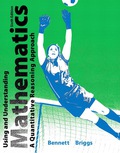
Concept explainers
Interpreting Policies. A city charters sole policy on reelection states
A person who has served three consecutive terms of four years each shall be eligible for appointment, nomination for or election to the office of councilmember no sooner than for a term beginning eight years after completion of that councilmember ’s third consecutive full term.
a. What is the maximum number of consecutive years that a councilmember could serve?
b. How many years must a councilmember who has served three consecutive full terms wail before running for office again?
c. Suppose a councilmember has served two consecutive full terms and is then defeated for reelection. According to this provision, is she or he required to wait 8 years before running for office again?
d. Suppose a councilmember serves three consecutive full terms and is reelected 10 years later. According to this provision, how many consecutive terms can she or he serve at that time?
Want to see the full answer?
Check out a sample textbook solution
Chapter 1 Solutions
EBK USING AND UNDERSTANDING MATHEMATICS
- Find the length of the following curve. 3 1 2 N x= 3 -y from y 6 to y=9arrow_forward3 4/3 3213 + 8 for 1 ≤x≤8. Find the length of the curve y=xarrow_forwardGiven that the outward flux of a vector field through the sphere of radius r centered at the origin is 5(1 cos(2r)) sin(r), and D is the value of the divergence of the vector field at the origin, the value of sin (2D) is -0.998 0.616 0.963 0.486 0.835 -0.070 -0.668 -0.129arrow_forward
- 10 The hypotenuse of a right triangle has one end at the origin and one end on the curve y = Express the area of the triangle as a function of x. A(x) =arrow_forwardAre there any unusually high or low pH levels in this sample of wells?arrow_forwardAn angle measures 70.6° more than the measure of its supplementary angle. What is the measure of each angle?arrow_forward
- Please solve the following Probability Problem: Show all work and complete what is askedarrow_forwardPlease solve the following probability problem. Show all work and must solve all parts HW 1.z. (Mingle)A number is called and players need to group up and enter rooms. Ifplayers do not manage to make it into the rooms in time, or if a room hasless or more players than it is supposed to have, they will be eliminated.Assume there are 200 people other than you and the number called is 10.Determine the probability that you will form the group of the correct sizein each of the following cases:a) Imagine you had no better strategy than going to each of the 200people and tossing a fair coin to determine if they will join yourgroup or not.b) Imagine everybody else is divided into 25 groups of 4 people and 20groups of 5 people. Among all the possible groups, you are choosingto join two at random.c) Imagine everybody else is divided into 20 groups of 4 people, 10groups of 2 people and 20 groups of 5 people. You are choosing tojoin two groups at random.d) Imagine everybody else is divided into 20…arrow_forwardIn Problems 17-26, solve the initial value problem. 17. dy = (1+ y²) tan x, y(0) = √√3arrow_forward
- Algebra & Trigonometry with Analytic GeometryAlgebraISBN:9781133382119Author:SwokowskiPublisher:Cengage

 College Algebra (MindTap Course List)AlgebraISBN:9781305652231Author:R. David Gustafson, Jeff HughesPublisher:Cengage Learning
College Algebra (MindTap Course List)AlgebraISBN:9781305652231Author:R. David Gustafson, Jeff HughesPublisher:Cengage Learning


